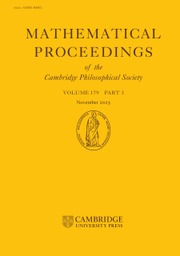The expansion of an arbitrary function in a series of conal or toroidal functions
Published online by Cambridge University Press: 24 October 2008
Extract
1. Particular series of conal and toroidal functions have been studied by various authors*, but so far no method has been given of expanding an arbitrary function in such a series. Ordinary methods fail, since conal functions (and also toroidal functions) are not orthogonal, although they form a complete set. In this paper I give an expansion theorem.
- Type
- Research Article
- Information
- Mathematical Proceedings of the Cambridge Philosophical Society , Volume 34 , Issue 1 , January 1938 , pp. 30 - 32
- Copyright
- Copyright © Cambridge Philosophical Society 1938
References
* Cf. Ganesh, Prasad, Bull. Calcutta Math. Soc. 23 (1931), 115;Google ScholarShabde, N. G., Bull. Calcutta Math. Soc. 23 (1931), 155.Google Scholar
† Hobson, , The theory of spherical and ellipsoidal harmonics (Cambridge, 1931), p. 451,Google Scholar equation (c).
‡ Whittaker, and Watson, , Modern analysis, 4th ed. (Cambridge, 1927), p. 229.Google Scholar
* Hobson, op. cit., p. 267, equation (130).
† Watson, , Theory of Bessel functions (Cambridge, 1922),Google Scholar chapter 19; cf. also the methods employed by Levinson, , Annals of Math. 37 (1936), 919–936.CrossRefGoogle Scholar
‡ A is said to be closed if f n → f and Af n → g imply that Af is defined and equal to g, the limits being taken in the metric.
* See Rellich, , Math. Ann. 110 (1934), 342–56.CrossRefGoogle Scholar
- 3
- Cited by


